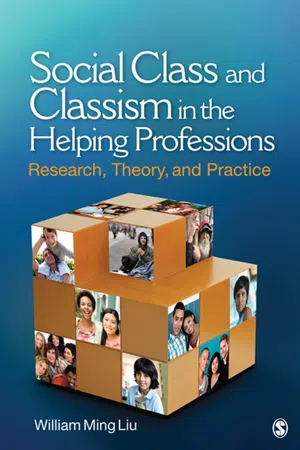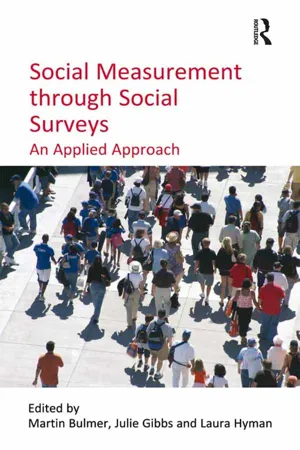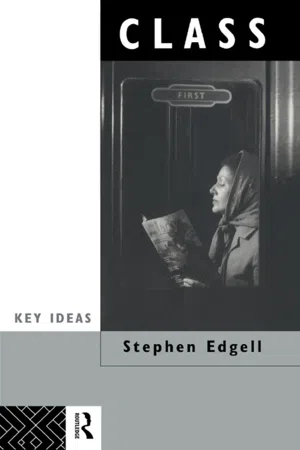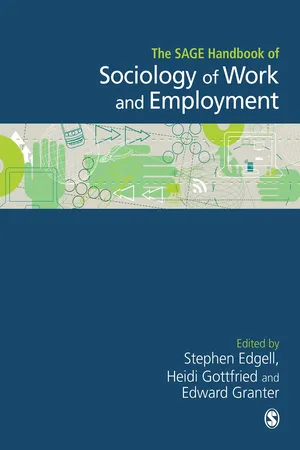Social Sciences
Defining and Measuring Social Class
"Defining and Measuring Social Class" involves categorizing individuals or groups based on their economic, social, and cultural characteristics. This can be done using various indicators such as income, education, occupation, and lifestyle. The measurement of social class helps researchers and policymakers understand social inequalities and their impact on society.
Written by Perlego with AI-assistance
Related key terms
6 Key excerpts on "Defining and Measuring Social Class"
- eBook - ePub
Social Class and Classism in the Helping Professions
Research, Theory, and Practice
- William Ming Liu(Author)
- 2010(Publication Date)
- SAGE Publications, Inc(Publisher)
The converse to these bobos are those I would regard as the “passers.” These are individuals who may come from humble and poor backgrounds but aspire to be wealthy and affluent. These individuals want to be perceived by others as part of a particular social class, so they take on the behaviors and attitudes that mimic those in higher social classes. These folks may be dishonest about their backgrounds or be vague and opaque. It may be extremely difficult for the helping professional to have these individuals reveal their true social class background. These individuals may also be in a recurring debt cycle—probably a lifestyle largely leveraged on credit cards and other loans or extended mortgages—so that they may pursue or express a particular lifestyle or material excesses that are valued by the higher-social-class group to which they aspire. For these individuals, current ways of understanding their social class experiences and perceptions do not capture the complexity of how they conceptualize themselves as part of a social class group.Implications for Practice
Throughout this chapter I have attempted to identify the shortcomings of current theories, paradigms, and frameworks on measuring social class and classism. Here, I will distill what I have presented into some practical considerations for helping professionals.1. Helping professionals should identify specific variables of social class and define them in ways that may be observed and measured. Operationalizing these variables and even connecting these variables to a larger coherent theory of social class is important in research.2. Try to provide some context to the data about to be collected. If income or some other discrete variable is of interest, provide a reference point by which a comparison may be made. For instance, examine demographic or census tract data about income for the specific population or community being measured and present these data.3. Look for measures or portions of measures that may be used or adapted to assess for social class or classism. Rather than looking only for social class measures, helping professionals may look broadly at other ways social class is conceptualized such as social status, mobility, self-perception, acculturation, identity, or worldview. These measures should reflect some psychological, interpersonal, or intrapsychic experience and not a measure of classification or categorization.4. Always give some consideration to the role of classism in social class. Helping professionals should consider social class and classism to be interdependent constructs that provide meaning and information to each other much like race and racism or gender and sexism, to name a few. Self-perceptions and attitudes of social class are often shaped by socialization and experiences with discrimination (i.e., classism), so there is a compelling interest to consider both. - eBook - ePub
Social Measurement through Social Surveys
An Applied Approach
- Julie Gibbs, Martin Bulmer(Authors)
- 2016(Publication Date)
- Routledge(Publisher)
Chapter 6Measuring Social ClassEric Harrison*Introduction
This chapter deals with the issues raised when social scientists wish to make use of survey instruments to measure social class and explore its effects. It is organized in the following way. It starts by explaining the continuing salience of class as a sociological variable, and its importance as a core component of large-scale social surveys. The following section explains the need for conceptually grounded models of class, and discusses one such model (EGP) based on the theory of employment relations. Part three discusses the data requirements for its full operationalization via a combination of information on occupation, employment status and supervisory responsibility. The next part goes on to explore the limitations of real-world survey data and some pragmatic steps that can be taken to deal with incomplete and imperfect information from questionnaires. Part five explores the concept of ‘validation’ in relation to measures of class, and the extent to which this is achieved in practice. The final section evaluates the current relationship between class analysis and survey research and makes suggestions for future improvements.The Continuing Significance of Class
Class holds a unique position in the canon of sociological concepts. It is arguably the discipline’s most hotly contested concept, and yet it also remains its most powerful. As has often, rather wistfully, been remarked, class is ‘sociology’s only independent variable’. If this really is a paradox, then it has always been so. Indeed, ‘talk of class being in decline is not novel, it is one of the constants’ (Roberts, 2001: 11). Most, if not all, of this kind of debate stems from a lack of clarity about what class actually is - eBook - ePub
- Vijai P. Singh(Author)
- 2017(Publication Date)
- Routledge(Publisher)
There are some methodological constraints on researchers developing strategies for studying social class. It may be possible that not all persons in a society can identify themselves and others as belonging to meaningful classes. In smaller communities it may still be possible that most people have some notion of their general positions in relation to others and also some reasonable understanding of the number of classes, but in larger communities this may not be feasible. The number of classes which are identified and the delineation of boundaries are influenced by the value system of the subject society.It is possible that a researcher and his respondents may not agree on the number of classes or on the boundaries of those agreed upon. One way of attempting to solve this problem is by developing an index on the basis of objective criteria which can be used to define classes. But if such classes are being related to some other phenomena, then it is possible that the various components of the index may not be identically related to the dependent variables. Another problem with such objective measures is that they do not take into account life-style variables that are “… reflected in social participation, residential area, house type, living room equipment and other visible aspects of status which serve to arrange the population hierarchically, if not to segregate it into classes.”60If objective status variables are salient, then they should be positively associated with life-style variables. However, the degree of association between these two sets of variables required by the researchers may vary on the basis of their conceptualization of social class and the purpose behind that conception.The concepts and principles we have discussed have been extensively used in the study of stratification of Western societies. But they are not culture-bound and they can be applied elsewhere. In Western societies achievement exerts greater influence than ascription on the stratification system, and the converse may be found in non-Western societies. More specifically, occupational status may explain a greater proportion of variance in the stratification system in Western societies than in non-Western societies, but there is no reason why it should not be used in the latter as one of the dimensions of the stratification system. All one needs to do is to examine whether occupational prestige is comparable over time and across societies before various stratification systems are compared. The use of concepts and methods with necessary modifications to suit the local cultural conditions would enable us to understand better how various types of stratification systems are created, maintained and changed. - eBook - ePub
Class
Key Concept in Sociology
- Stephen Edgell(Author)
- 2008(Publication Date)
- Routledge(Publisher)
3 The measurement of classINTRODUCTION
The process by which the classical and contemporary approaches to the meaning of class discussed in the first two chapters are transformed from a theoretical idea into a measurable form is called operationalization. On the assumption that it is both desirable and possible to develop a ‘scientific sociology’, the process of operationalizing concepts is crucial to the achievement of reliable (i.e. the extent to which repeated measurements produce the same results under the same conditions) and valid (i.e. the extent to which a measure is an accurate representation of the phenomenon the researcher wishes to investigate) empirical data. Thus, operational definitions impart clarity and precision to sociological analysis and are therefore at the core of empirical sociology (cf. Pawson 1989). Since class is simultaneously one of the most important and widely used and abused concepts in sociology, in addition to being one of the most controversial, it is imperative to be clear from the outset not only what one means by the term, but also how one intends to measure it. Until recently, this aspect of class analysis had received little attention in contrast to the plethora of theoretical and substantive contributions. The change in emphasis has been stimulated by the reorientation of neo-Marxism away from abstract theorizing and toward empirical analysis (e.g. Wright 1979), and by the emergence of a feminist critique of ‘malestream’ sociology (Abbott and Wallace 1990). - eBook - ePub
Being Middle Class in China
Identity, Attitudes and Behaviour
- Ying Miao(Author)
- 2016(Publication Date)
- Routledge(Publisher)
It is worth noting that although many surveys, including the one conducted here, use the term ‘middle strata’ without the emphasis on property, it is still referred to and understood as the middle class. Indeed, the data show that economic indicators are the most significant factors in the respondents’ internalisation of their class, middle or otherwise. This shows that economic well-being still underlines perceived class positions, in that it provides a solid foundation for their class identity.Middle strata, salaried class?
There are two usual ways to ascertain an individual’s subjective position in society: by asking him to grade himself on a linear social spectrum, or by asking him to place himself in a given class category. The one who positioned himself in the middle of society, or into the middle class category, is usually considered as self-identified middle class. The former approach offers more flexibility by removing potentially murky connotations of class from social stratification itself, while the latter provides a more concrete setting for subjective class identification. However, even with the latter categorisation, class is typically given interchangeably with ‘strata’, and denotes one’s identification of position in society rather than any identification with a label with sociological meaning. For instance, ‘working class’ is usually not included in the categories given, despite its lasting significance in academic research, as well as its widespread usage in public. When the term ‘gongxin jieceng ’ is included alongside other conventional class categories in a survey in Ningbo, an interesting mismatch appeared: in a sample of 181 middle class respondents by objective criteria, 66 per cent placed themselves around the middle of society (four to six on the social spectrum), 79 per cent middle and above (four and above), but only 46 per cent considered themselves specifically ‘middle class’, while 48 per cent considered themselves ‘salaried class’ instead (Table 2.1 - Stephen Edgell, Heidi Gottfried, Edward Granter(Authors)
- 2015(Publication Date)
- SAGE Publications Ltd(Publisher)
Categorical approaches to class, as the name implies, group individuals into different class categories, depending on specified attributes. Scholars differ as to which attributes they find most salient for creating class categories, how many categories exist, and how those categories relate to each other. What they have in common are the ideas that (1) societies are divided into classes, and (2) membership in a given class shapes individuals’ life experiences, perceptions of the world, and material well-being.Class categories have both objective and subjective dimensions. The ‘objective’ dimension of class refers to the structural, socio-economic factors that place an individual in one class or another, independent of that individual's awareness of being in that class. The ‘subjective’ dimension of class refers to the degree to which an individual recognizes the existence of class divisions, and identifies as a member of a particular class. Scholars often refer to the objective and subjective dimensions of class as ‘class position’ and ‘class identity'.Unlike gradational approaches to class, categorical approaches place much more analytical weight on how class categories are defined and delineated from each other. For example, if we limit our definition of ‘working class’ to include only manual ‘blue-collar’ workers, then that class will appear much less prominent than if we use a more expansive definition based on how much control someone has over their working conditions, or whether someone's primary means of subsistence comes from selling their own capacity to work as opposed to purchasing other people's capacity to work. That broader definition could include not only blue-collar workers, but many ‘white-collar’ office workers and ‘pink-collar’ service workers as well. While the distinction on the surface seems to be merely about the size and composition of a given class category, different conceptions of who is or is not part of the ‘working class’ category can have implications for understanding how socially prominent or relevant that class is, and how members of that class act socially, culturally, and politically.
Learn about this page
Index pages curate the most relevant extracts from our library of academic textbooks. They’ve been created using an in-house natural language model (NLM), each adding context and meaning to key research topics.





